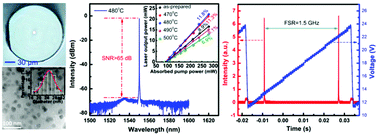Enhanced single-mode fiber laser emission by nano-crystallization of oxyfluoride glass-ceramic cores†
Abstract
Fiber lasers, especially single-frequency fiber lasers, are highly desirable due to their long coherent length and narrow spectral linewidth that are unattainable in common photonic devices. However, significant challenges in the fabrication of high quality fiber laser devices still exist. In this paper, fibers with 1.55 μm laser output have been achieved using Er3+/Yb3+-codoped glass-ceramic (GC) as a core material and a “molten core” fiber-drawing technique. The prepared GC fibers demonstrate enhanced laser output with an optical signal-to-noise ratio of 65 dB and a slope efficiency of 11.8%, which are higher than those of the as-prepared glass fiber. Furthermore, a single-longitudinal mode laser with a linewidth of 7.4 kHz and a relative intensity noise (RIN) of −148.8 dB/Hz is achieved, manifesting the potential applications of the GC fibers in optoelectronic fields. Theoretical calculations and simulations are employed to understand the relation between the optical performance of the fiber laser and the atomic structure in the phase-separated region of the oxyfluoride glass cores. The demonstrated GC fibers provide a new platform for the development of multifunctional fiber lasers and open a new avenue towards practical applications for crystallized fibers.



 Please wait while we load your content...
Please wait while we load your content...